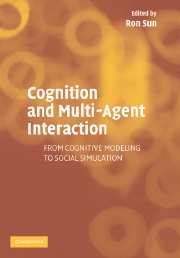Book contents
- Frontmatter
- Contents
- List of Contributors
- Preface
- PART 1 INTRODUCTION
- PART 2 OVERVIEWS OF COGNITIVE ARCHITECTURES
- PART 3 MODELING AND SIMULATING COGNITIVE AND SOCIAL PROCESSES
- 5 Cognitive Architectures, Game Playing, And Human Evolution
- 6 Simulating A Simple Case Of Organizational Decision Making
- 7 Cognitive Modeling of Social Behaviors
- 8 Cognitive Agents Interacting in Real and Virtual Worlds
- 9 Modeling Social Emotions and Social Attributions
- 10 Communicating and Collaborating with Robotic Agents
- 11 Behavior-Based Methods for Modeling and Structuring Control of Social Robots
- 12 Evolution of a Teamwork Model
- 13 Sociality in Embodied Neural Agents
- 14 Cognitive Architecture and Contents for Social Structures and Interactions
- PART 4 A SYMPOSIUM
- Index
13 - Sociality in Embodied Neural Agents
Published online by Cambridge University Press: 15 December 2009
- Frontmatter
- Contents
- List of Contributors
- Preface
- PART 1 INTRODUCTION
- PART 2 OVERVIEWS OF COGNITIVE ARCHITECTURES
- PART 3 MODELING AND SIMULATING COGNITIVE AND SOCIAL PROCESSES
- 5 Cognitive Architectures, Game Playing, And Human Evolution
- 6 Simulating A Simple Case Of Organizational Decision Making
- 7 Cognitive Modeling of Social Behaviors
- 8 Cognitive Agents Interacting in Real and Virtual Worlds
- 9 Modeling Social Emotions and Social Attributions
- 10 Communicating and Collaborating with Robotic Agents
- 11 Behavior-Based Methods for Modeling and Structuring Control of Social Robots
- 12 Evolution of a Teamwork Model
- 13 Sociality in Embodied Neural Agents
- 14 Cognitive Architecture and Contents for Social Structures and Interactions
- PART 4 A SYMPOSIUM
- Index
Summary
INTRODUCTION
This chapter addresses the topic of how embodied neural agents coordinate together to exhibit interesting social behaviors. Embodied neural agents are defined in this Introduction. Sections 2 through 5 describe simulations of collective phenomena emerging from the interactions among embodied neural agents living in the same environment. Section 2 discusses spatial aggregation and proto-social behavior, Section 3 communication, and Section 4 cultural evolution. Section 5 summarizes the chapter and draws some conclusions.
Neural agents are agents whose behavior is controlled by neural networks, that is, by control systems that reproduce in simplified ways the physical structure and the physical way of functioning of the nervous system. A neural network is a set of units (neurons) linked by unidirectional connections (synapses between neurons). Connections have a quantitative weight (number of synaptic sites between pairs of neurons) and a plus or minus sign (excitatory and inhibitory synapses). At any given time every unit has an activation level (firing rate of neurons) that depends on either physico/chemical events outside the network (input units) or the sum of excitations and inhibitions arriving to the unit from connected units (internal and output units). Activation propagates from the input units to the output units through one or more intermediate layers of internal units. The pattern of activation of the output units determines some effect outside the network.
At the level of the individual agent the network's architecture of connections and the weights of the individual connections can change as a consequence of the agent's interactions with the external environment, and these changes translate into changes in behavior.
- Type
- Chapter
- Information
- Cognition and Multi-Agent InteractionFrom Cognitive Modeling to Social Simulation, pp. 328 - 354Publisher: Cambridge University PressPrint publication year: 2005
- 2
- Cited by



